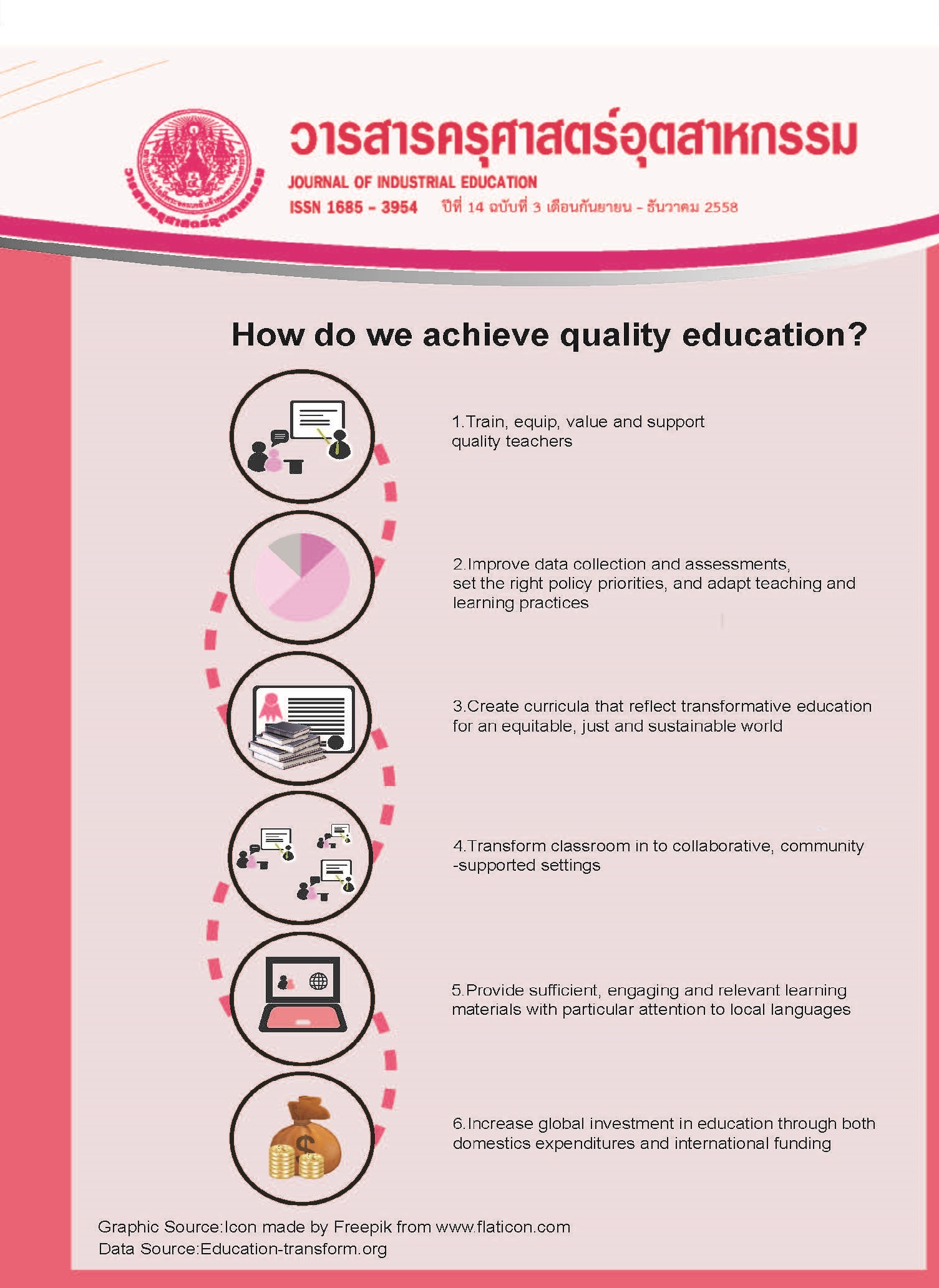รูปแบบความรู้การประเมินวัฏจักรชีวิตผลิตภัณฑ์พลาสติกสำหรับนักเรียนมัธยมศึกษาตอนต้น
Main Article Content
บทคัดย่อ
วัตถุประสงค์การวิจัยเพื่อพัฒนารูปแบบความสัมพันธ์เชิงโครงสร้างของความรู้การประเมินวัฎจักรชีวิตพลาสติกและสิ่งแวดล้อมศึกษาที่มีผลต่อพฤติกรรมการอนุรักษ์เพื่อบรรเทาภาวะโลกร้อนผ่านแรงบันดาลใจในการมีจิตสาธารณะ ประชากรเป็นนักเรียนมัธยมศึกษาตอนต้นในสำนักงานเขตพื้นที่การศึกษามัธยมศึกษาเขต 26 ภาคตะวันออกเฉียงเหนือ ปีการศึกษา 2555 จำนวน 18,871 คน ใช้แบบสอบถามเป็นเครื่องมือในการเก็บรวบรวมกลุ่มตัวอย่างจำนวน 400 คน โดยใช้การสุ่มแบบแบ่งกลุ่มและนำรูปแบบสมการเชิงโครงสร้างใช้ในการพิสูจน์รูปแบบ คุณภาพของเครื่องมือมีค่า IOC>0.50 และค่าความเชื่อมั่นทั้งฉบับ 0.971
ผลการวิจัยพบว่าเมื่อพิจารณารูปแบบโครงสร้างของปัจจัยองค์ประกอบเชิงยืนยันของความรู้การประเมินวัฎจักรชีวิตพลาสติก (LCAP) และสิ่งแวดล้อมศึกษา (EE) สามารถอธิบายความแปรปรวนของตัวแปรแฝงภายในแรงบันดาลใจในการมีจิตสาธารณะ (IPM) ที่มีผลต่อพฤติกรรมการอนุรักษ์สิ่งแวดล้อมเพื่อบรรเทาภาวะโลกร้อนได้ร้อยละ 78.00 และปัจจัยองค์ประกอบเชิงยืนยันของความรู้การประเมินวัฎจักรชีวิตพลาสติก (LCAP) และสิ่งแวดล้อมศึกษา (EE) สามารถอธิบายความแปรปรวนตัวแปรแฝงภายในแรงบันดาลใจในการมีจิตสาธารณะ (IPM) ได้ร้อยละ 68.00
Article Details
"ข้อคิดเห็น เนื้อหา รวมทั้งการใช้ภาษาในบทความถือเป็นความรับผิดชอบของผู้เขียน"
References
[2] Lave, L. B., E. Cobas-Flores, C. T.Hendrickson, and F. C. McMichael. 1995. Using input-Output analysis to estimate economy-wide discharges. Environmental Science and Technology, 29(9), 420A–426A.
[3] Miettinen, P. and R. Hamalainen. 1997.How to benefit from decision analysis in environmental lifecycle analysis. European Journal of Operations Research, 102(1), 279–294.
[4] Joshi, S. 2000. Product Environmental Life-Cycle Assessment Using Input-Output Techniques. Journal of Industrial Ecology, 3(2-3), 2000.
[5] O’Neill, T.J. 2003. Life Cycle Assessment and Environmental Impact of Plastic Products. Toronto: ChemTec Publishing.
[6] Answer. 2013. How does plastic effects the environment? Retrieved April 25,2013, from https://wiki.answers.com/Q/How_does_plastic_effects_the_environment
[7] Graiver, D. Farminer, K.W., & Narayan,R. 2003. A Review of the Fate and Effect of Silicones ion Environment. Journal of Polymer and the Environment,11(4), 2003.
[8] Joshi, S. 2000. Product Environmental Life-Cycle Assessment Using Input-Output Techniques. Journal of Industrial Ecology, 3(2-3), 2000.
[9] Volker, H. 2007. Brundtland Report:A 20 Years Update. Retrieved April 25,2013, from https://www.sd- network.eu/pdf/doc_berlin/ESB07_Plenary_Hauff.pdf
[10] Thiengkamol, N. 2011e. Environment and Development Book 1. (4th ed.). Bangkok: Chulalongkorn University Press.
[11] Thiengkamol, N. 2012h. Model of Environmental Education and Psychological Factors Affecting to Global Warming Alleviation. Mediterranean Journal of Social Sciences, 3 (11), 427-434.
[12] Donkonchum, S., & Thiengkamol, N. 2012. Model of Environmental Education and Psychological State Affecting to Global Warming Alleviation. International Proceedings of Economic Development and Research, 44(1), 1-5.
[13] Udonboon, C., Thiengkamol, N., &Thiengkamol, C. 2012b. Causal Relationship Model of Water Conservation Behavior. Mediterranean Journal of Social Sciences, 3(11), 591-604.
[14] Chomputawat, S., Thiengkamol, N., Thiengkamol Khoowaranyoo, T. 2013ab. Causal Relationship Model of Environmental Conservation Involved Psychological Factors for Agriculturist. European Journal of Scientific Research, 115 (1), 147-165.
[15] Koonboonchan, A., Thiengkamol, N., Thiengkamol Khoowaranyoo, T. 2013a. Causal Relationship Model of Global Warming Alleviation Integrated with Four Noble Truths and Psychological State. European Journal of Scientific Research, 104(3), 418-433.
[16] Prasertsri, N., Thiengkamol, N., Thiengkamol Khoowaranyoo, T. 2013b. “Casual Relationship Model of Learning Behavior of Information Technology Integrated with Psychological Factors. European Journal of Scientific Research, 104 (3), 488-503.
[17] Saisunantharom, S. Thiengkamol, N., Thiengkamol, C. 2013a. Casual Relationship Model of Biodiversity Conservation.European Journal of Scientific Research,104(3), p.460-474.
[18] Suebsing, S., Thiengkamol, N., Thiengkamol, C. 2013a. Causal Relationship Model of Forest Conservation Integrated with Psychological State. European Journal of Scientific Research, 104 (3), 447-459.
[19] Thiengkamol, N. 2012d. Model of Psychological Factors Affecting to Global Warming Alleviation. International Proceedings of Economic Development and Research, 44(1), 6-12.
[20] Jongwutiwes, N., Thiengkamol, N., & Thiengkamol, T. 2012b. Causal Relationship Model of Hospital Environmental Management. Mediterranean Journal of Social Sciences, 3 (11), 447-458.
[21] Kamin, P., Thiengkamol, N., Thiengkamol Khoowaranyoo, T. 2014. Environmental Education and Public Mind Affecting Forest Conservation Behavior. Journal of Industrial Education, 13(3), 181-187.
[22] Dejkunchorn, D., Prasertsri, N., Thiengkamol Khoowaranyoo, T. 2014. Development Model of School Landscape Management for Environmental Conservation. Journal of Industrial Education, 13 (3), 157-164.
[23] Srikaewtoom, N., Thiengkamol, N., Thiengkamol, C. 2014. Development Model of Biodiversity Conservation. Environmental Conservation. Journal of Industrial Education, 13 (3), 142-148.
[24] Srichaimool, P., Prasertsri, N., Thiengkamol, C. 2014. Development Model of Household Food Security Management. Journal of Industrial Education, 13(3), 149-156.
[25] Lavrakas, P.J. 2008. Encyclopedia of Survey Research Methods. New York : Sage.
[26] Rovinelli, J., & Hambleton, K. 1977. On the use of content specialists in the assessment of criterion- referenced test item validity. Dutch Journal of Educational Research, 2(1), 49-60.
[27] Cronbach, J. 1951. Coefficient alpha and the internal structure of tests. Psychometrika, 16(3), 297–334.

